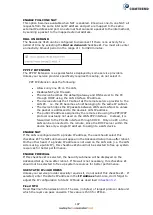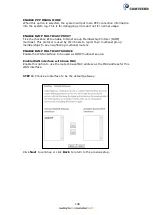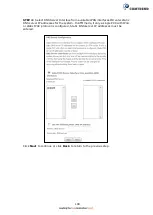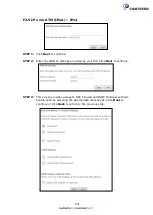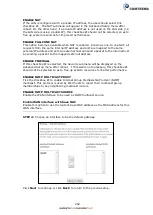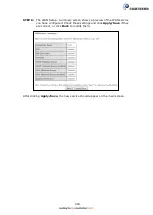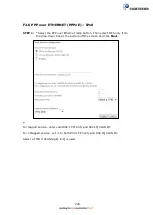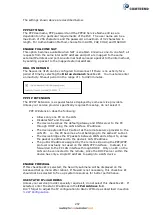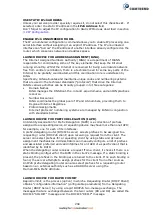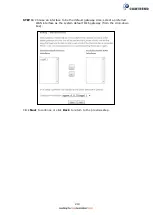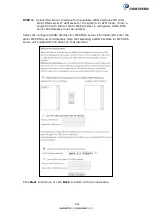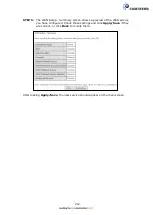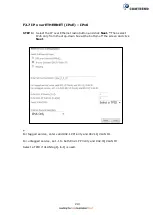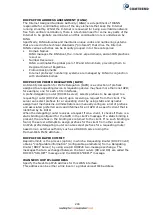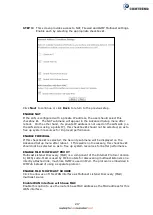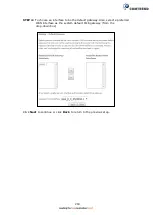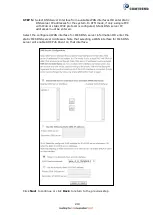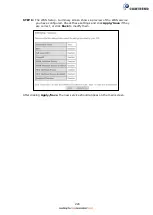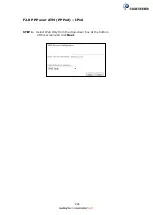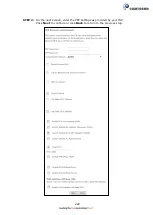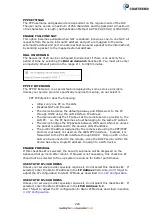
208
USE STATIC IPv6 ADDRESS
Unless your service provider specially requires it, do not select this checkbox
. If
selected, enter the static IP address in the
IPv6 Address
field.
Don’t forget to adjust the IP configuration to Static IP Mode as described in section
ENABLE IPv6 UNNUMBERED MODEL
The IP unnumbered configuration command allows you to enable IP processing on a
serial interface without assigning it an explicit IP address. The IP unnumbered
interface can "borrow" the IP address of another interface already configured on the
router, which conserves network and address space.
LAUNCH DHCP6C FOR ADDRESS ASSIGNMENT (IANA)
The Internet Assigned Numbers Authority (IANA) is a department of ICANN
responsible for coordinating some of the key elements that keep the Internet
running smoothly. Whilst the Internet is renowned for being a worldwide network
free from central coordination, there is a technical need for some key parts of the
Internet to be globally coordinated, and this coordination role is undertaken by
IANA.
Specifically, IANA allocates and maintains unique codes and numbering systems
that are used in the technical standards (“protocols”) that drive the Internet.
IANA’s various activities can be broadly grouped in to three categories:
•
Domain Names
IANA manages the DNS Root, the .int and .arpa domains, and an IDN practices
resource.
•
Number Resources
IANA coordinates the global pool of IP and AS numbers, providing them to
Regional Internet Registries.
•
Protocol Assignments
Internet protocols’ numbering systems are managed by IANA in conjunction
with standards bodies.
LAUNCH DHCP6C FOR PREFIX DELEGATION (IAPD)
An Identity Association for Prefix Delegation (IAPD) is a collection of prefixes
assigned to a requesting device. A requesting device may have more than one IAPD;
for example, one for each of its interfaces.
A prefix-delegating router (DHCPv6 server) selects prefixes to be assigned to a
requesting router (DHCPv6 client) upon receiving a request from the client. The
server can select prefixes for a requesting client by using static and dynamic
assignment mechanisms. Administrators can manually configure a list of prefixes
and associated preferred and valid lifetimes for an IAPD of a specific client that is
identified by its DUID.
When the delegating router receives a request from a client, it checks if there is a
static binding configured for the IAPD in the client’s message. If a static binding is
present, the prefixes in the binding are returned to the client. If no such binding is
found, the server attempts to assign prefixes for the client from other sources.
An IPv6 prefix delegating router can also select prefixes for a requesting router
based on an external authority such as a RADIUS server using the
Framed-IPv6-Prefix attribute.
LAUNCH DHCP6C FOR RAPID COMMIT
Rapid-Commit; is the process (option) in which a Requesting Router (DHCP Client)
obtains "configurable information" (configurable parameters) from a Delegating
Router (DHCP Server) by using a rapid DHCPv6 two-message exchange. The
messages that are exchanged between the two routers (RR and DR) are called the
DHCPv6 "SOLICIT" message and the DHCPv6 "REPLY" message.
Summary of Contents for NexusLink 3120
Page 41: ...40 5GHz ...
Page 60: ...59 5 3 4 UPnP Select the checkbox provided and click Apply Save to enable UPnP protocol ...
Page 70: ...69 A maximum of 100 entries can be added to the URL Filter list ...
Page 87: ...86 ...
Page 123: ...122 Enter the MAC address in the box provided and click Apply Save ...
Page 167: ...166 STEP 2 Click the Windows start button Then select Control Panel ...
Page 168: ...167 STEP 3 Select Devices and Printers STEP 4 Select Add a printer ...
Page 196: ...195 F2 4 PPP over ATM PPPoA IPv4 STEP 1 Click Next to continue ...
Page 216: ...215 Click Next to continue or click Back to return to the previous step ...




